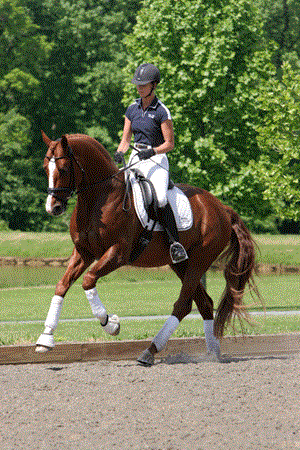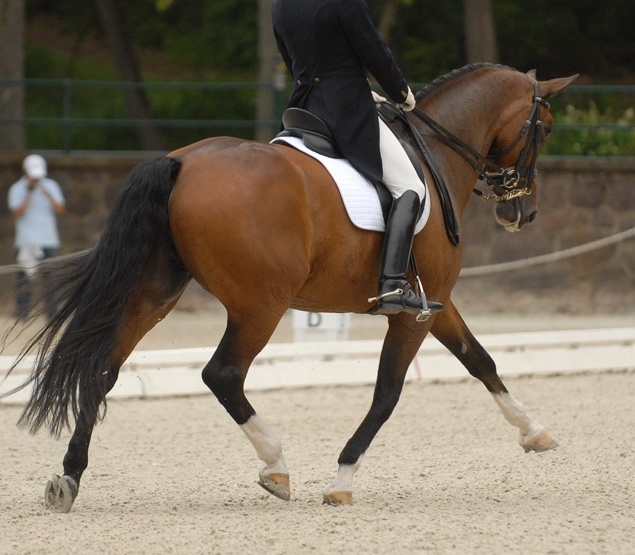Q: Whenever I ask my horse to lengthen his stride after the collected canter, he starts to run and I lose control over the canter. Could you give me a few exercises that help improve transitions between collected canter and lengthening the strides at the canter? My horse is a 6-year-old, 17-hand Oldenburg gelding.
A: First of all, let me clarify a semantic problem that arises in your question. You are asking about canter lengthenings out of the collected canter. Correctly stated, it would be medium canter out of the collected canter (or canter lengthenings out of the working canter). My following response assumes that you are working on canter lengthenings out of the working canter, though the corrections would be the same.

canter lengthening, you have a
chance to confirm that your horse
is truly stepping under his center
of balance and has a degree of
self-carriage. (Credit: Richard Malgrem)
By nature, the horse carries 60 percent of his weight on his forehand because the weight of his shoulders, neck and head is greater than the weight of his hindquarters. At First Level we’re hoping for a horizontal balance, meaning that the horse, through training, is starting to carry his weight more equally distributed between the forehand and haunches. This is when the canter lengthening is first introduced. The added velocity of the lengthening easily tips the horse’s weight back onto the forehand to the 60/40 ratio and creates a lack of balance and that “running” feeling.
Here are three basic exercises that will help you with both the transition into and back from the lengthening.
Exercise 1: Canter on a 20-meter circle centered between E and B. Circle 15 meters at E, then lengthen on the open side of the circle and as you balance back to the working canter, circle 15 meters at B. By circling 15 meters before the lengthening, you have a chance to confirm that your horse is truly stepping under his center of balance and has a degree of self-carriage. To test this, you should be able to give your inside hand forward for several strides and maintain the bend. By beginning to lengthen on the arc of the 20-meter circle, your horse will more naturally keep his inside hind leg under his body, which will contribute to keeping a better balance in the lengthening. Using the 15-meter circle to bring the horse back teaches him to accept the half halt (bringing the horse back) in this transition because the rider can more easily continue to use the diagonal aids of inside leg to outside rein by virtue of turning onto the circle rather than pulling straight back. This teaches the horse to transition back from the lengthening by lowering his inside hip and slightly rounding his pelvis rather than by straightening in his hind legs and bracing in his back.
Exercise 2: Ride a 10-meter circle at the beginning of a long side, lengthen half-way down the long side, balance back to a working canter at E/B by using another 10-meter circle, then lengthen the second half of the long side and circle 10 meters at the end of the long side for the final transition back. Use the first 10-meter circle to get the same stepping-under feeling that you created on the initial 15-meter circle in Exercise 1. Come out of the 10-meter circle and ride straight on the long side for several strides as you transition into the lengthening. It’s extremely important to establish this straightness before and during your transition into the lengthening. Most horses will lean their shoulders toward the wall and put their haunches to the inside of the track, thus unloading the weight from their hindquarters as they begin to lengthen, creating the running feeling you mentioned. The second 10-meter circle helps you to regain any balance you’ve lost by re-establishing the inside-leg-to-outside-rein connection and teaches the horse that he must listen to your half halts during a lengthening. And the third circle teaches both you and the horse to use the corner at the end of the long side to rebalance correctly by using the same diagonal aids that you used in the first exercise to teach your horse to lower his inside hip and bend his hind-leg joints when coming back from the canter lengthening.
Exercise 3: Come through the second corner of the short side with the same bend and balance that you created on the initial 10-meter circle from Exercise 2. Establish straightness for several strides at the beginning of the long side. Lengthen the whole long side and balance back to a working canter at the end of the long side. If you’ve schooled Exercise 2 a series of times, your horse will be anticipating the 10-meter circle at E/B as well as at the end of the long side and should think about rebalancing himself partway through the lengthening and at the final corner. The trick is to continue to use your inside-leg-to-outside-rein aids throughout your lengthening as if you are going to start a 10-meter circle at the beginning, middle and end of your long side. If you feel your horse isn’t listening or you’ve lost the coordination of the aids, just add the circles back in.
If you school these exercises regularly, your horse will develop straight, balanced and easy canter lengthenings. Have fun!
Joy Congdon is a USDF certified instructor through Fourth Level and an “L” Education Program graduate. An active competitor through the FEI levels, she operates Still Point Dressage in Shelburne, Vermont.











